


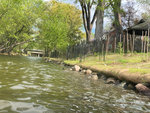
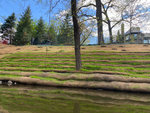
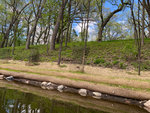

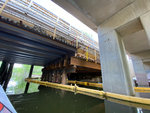
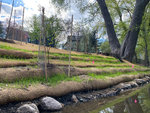
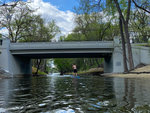
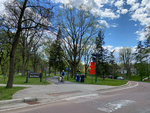
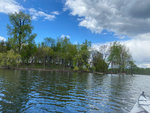

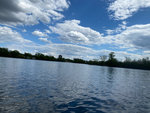
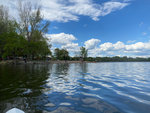
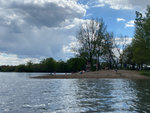
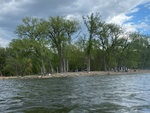
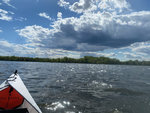
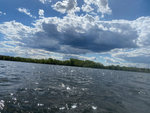


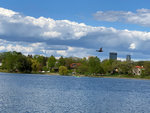
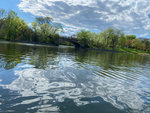
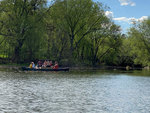
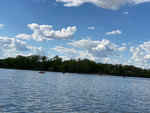
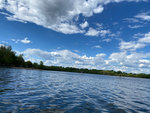
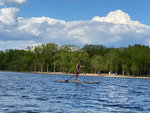
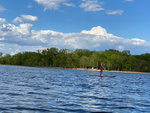
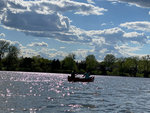
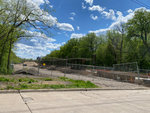
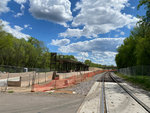
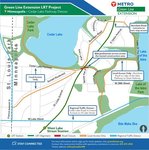

Soon, a light-rail train will stop in one of the most natural areas of Minneapolis. The Minneapolis Parks and Recreation Board (MPRB) is considering how to plan for the future of Cedar Lake and Lake of the Isles, and whether to build amenities there.
What they’re hearing from residents is a protest against anything that would take away from the natural feel of the park.
The comments submitted by residents through the master planning process for the area repeat this statement: Do not make Cedar Lake and Lake of the Isles a busy urban hub of activity like Harriet and Bde Maka Ska. A man-made approach will not make these lakes better.
People are asking why the guiding principals for the master planning project assume that more amenities are better.
“Have you considered that it’s ok to have a natural lake in the city? Do you realize how rare this already is?” asked one person via the online survey that closed on March 4. Anonymous comments and feedback were shared at an open house on April 30, the last public engagement process during the initial phase.
“Less is more,” wrote another. “Keep it green/natural. Keep it open. The fewer permanent structures the better. Lake of the Isles is not Lake Harriet or Bde Mka Ska. It has an entirely different feel and should remain that way. I think this intangible value gets lost in the discussion. It’s subtle. Probably unrecognized by most. It’s quiet, calm, peaceful. Lake of the Isles has the most green space of any of the Chain of Lakes. Or, at least it feels that way. And we should keep it that way. As residential development in Uptown and surrounding areas continues to grow, we are losing more and more green/open space. It is crucial that we maintain what is left. We need to consider that just being in a natural/open space is enough – without having to do something when we get there. We don’t need to be guided or entertained. Just clean water, trees, habitat, and well-maintained trails.”
“People can go elsewhere if they want a paved paths or amenities,” stated one comment.
The Cedar Lake-Lake of the Isles Master Plan (Cedar-Isles) will create a 20-30-year vision for Cedar Lake, a section of Cedar Lake Trail, Lake of the Isles and Dean Parkway. The process began in fall 2019 and is expected to finish in 2023. The Cedar-Isles area is the only part of the Minneapolis park system that does not have an updated plan, observed MPRB planner Emma R. Pachuta.
Some are concerned that the plan doesn’t include wetland restoration, and that no one has analyzed how any work on trails, bathroom buildings, rental kiosks, picnic pavilions or activity hubs will affect the wildlife.
One commenter wrote, “I would like to see that water quality and unique natural environment of Cedar Lake and surrounding parkland remain the highest priority.”
Another said, “Prioritize animal habitat and water quality over human desires. We as humans need to fit ourselves around the health of the lake and the wildlife preservation, not the reverse, for long-term health of the lake.”
Some are concerned about what they see as an attempt to “over commercialize” the lakes.
How does the existing turf grass in the area fit into the desire for a natural space? Some want the grass for recreation and others want to see “rewilding” or “littoral edge expansion.”
Another debate: Do improvements in this prosperous part of the city take away resources from other areas, or does it make things more equitable and inviting?
“MPRB cannot afford the infrastructure it has today,” wrote one person. “How can it afford to add more costly infrastructure to its portfolio? What is the long-term maintenance plan for keeping the infrastructure usable and safe? And how will we pay for it if we already are stretched to maintain what we have?”
Close the parkway?
Whether to close the parkways is a hotly debated topic, with some favoring the move and others against it. One concept calls for closing Lake of the Isles Parkway between 25th and 21st. By making Cedar Lake Parkway a one-way, there would be space for a two-way bike trail. Other ideas are to close the parkways occasionally, such as for events or on the weekends. But there are concerns about seniors and those with mobility issues accessing the area.
What’s up next? Is there a place for people to share input?
“We’re working on one preferred park concept based on all the feedback we received,” stated Pachuta. “We believe this next iteration will align more closely with what the community hopes to see.”
The preferred park concept will be released this summer, starting up another round of engagement. Staff will provide both in-person and online ways to weigh in. To sign up for email updates about the Cedar-Isles Master Plan, head to the project page: www.minneapolisparks.org/cedar-isles under the Get Involved tab.
Learn more from MPRB planner Emma Pachuta about this process:
How have you reached out to community members?
Pachuta: MPRB has implemented a number of strategies over the last couple of years to engage both nearby residents and regional audiences about their vision for this area of parkland. Strategies include online surveys, in-person events, online meetings, Community Collaborator projects, social media stories, presentations to neighborhood groups, in-person and virtual tours, signs in the parks, and in-person onsite interviews. We’re always adapting and trying new ideas to continue to get the word out to people who use or want to use the parks.
Public feedback highlights are regularly shared with the Cedar-Isles Community Advisory Committee (CAC). The CAC is charged with representing voices of the community and making final recommendations about the project. Community Engagement Summary Reports for the Visioning Phase and Initial Park Concepts phase are on the Cedar-Isles project page.
What have you heard from people so far?
Pachuta: We heard overwhelming support for making water quality improvements within the master plan project area, so we formed a Water Quality Subcommittee comprised of Community Advisory Committee members to identify water quality goals for the master plan. These goals were shared at CAC Meeting #10 in April, and will be front and center as the project team creates the preferred park concept.
Alongside the broad consensus about the importance of water quality, we heard a wide range of hopes and concerns. Check out the community engagement summary reports for the visioning phase and initial park concepts phase to learn more.
In what ways will this plan help mitigate the effects of climate change?
Pachuta: 1. Identifying rigorous water quality goals outlined by the CAC subcommittee
2. Incorporating design elements that proactively address climate change: increasing restored natural areas; implementing a “littoral edge” around both lakes (an area below the water’s edge that is permanently submerged with plants and aids in flood mitigation, water quality improvements, and has ecological benefits); and aiming to preserve natural areas and reduce erosion through formalizing and reducing the number of paths through natural areas, to name a few.
3. The master plan can prioritize projects, so it is possible to outline water quality or natural areas improvements as the first-tier priority for future improvements.
4. The water quality subcommittee plans to make high-level recommendations outside the scope of the master plan, including formalizing a collaborative community-agency citywide committee to continue monitoring and developing rapid solutions for water quality in the face of a changing climate.
What is the budget and where will the funds come from?
Pachuta: Parks and Trails Legacy funds are supporting the budget for the creation of the master plan. If or when the plan is adopted by the board of commissioners, staff will then work to begin identifying funding and implementation opportunities. A benefit of having an adopted master plan for a specific park area is that it often opens new funding opportunities that would not be available without an adopted plan.
Where are we currently in the master plan process?
Pachuta: MPRB just wrapped up the Initial Park Concepts phase, which is Phase 2 of 5 for the master plan process. MPRB Master Plan phases are as follows:
• Phase 1: Pre-design/visioning – fall 2019-summer 2021
• Phase 2: Initial park concepts – fall 2021-spring 2022. This is the phase that just ended.
• Phase 3: Preferred park concept – summer-fall 2022
• Phase 4: Draft plan – fall-winter 2022
• Phase 5: Final plan – winter 2022-spring 2023. Phase 5 is when the final plan is presented to park commissioners, who ultimately vote on whether to adopt it.
Two different initial park concepts were released in December 2021. MPRB gathered feedback and guidance from the public, partner organizations, internal staff, and the Community Advisory Committee to inform next steps. There were some “big ideas” presented in the initial park concepts. Some of the big ideas were not well-supported by the community, and will not make it into the preferred park concept.
Comments
No comments on this item Please log in to comment by clicking here